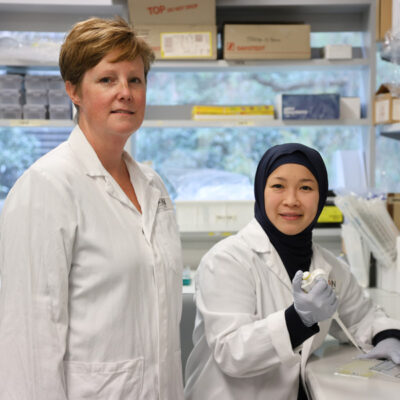Understanding what causes gastroenteritis, in the search for a cure
By Rob Clancy, staff writer. Reviewed by Dr Cristina Giogha
It’s a disease that causes millions of deaths worldwide every year, but there are still large gaps in our understanding of what causes gastroenteritis.

While it is well proven that certain Escherichia coli (E. coli) bacteria cause gastroenteritis there has been less understanding of just how it happens … until now.
How gastroenteritis is caused
Scientists at Hudson Institute of Medical Research investigated how E. coli destroy intestinal structures called microvilli, which are minuscule finger-like projections on intestinal cells that are vital for absorbing nutrients and water from the gut.
Researcher Dr Cristina Giogha said her research on the causes of gastroenteritis, published in the journal PNAS, could lead to new, more effective treatments.
“E. coli causes life-threatening diarrhoea, mainly in infants in low-income countries, so there is an urgent need for new and better gastroenteritis treatments,” Dr Giogha said.
Our work aims to understand the details of how these bacteria cause gastroenteritis, so new treatments can be designed, potentially saving thousands of lives, particularly in developing nations.”
Dr Giogha and Hudson Institute’s research team, working with colleagues at Melbourne’s Doherty Institute for Infection and Immunity, the University of Saskatchewan (Canada) and Vanderbilt University (USA) studied the phenomenon that certain gastroenteritis-causing E. coli drastically change the structure of intestinal cells during infection.
Hallmarks of gastroenteritis
“These bacteria destroy microvilli and form little pedestals that the bacteria sit upon,” Dr Giogha said. These pedestals are hallmarks of gastroenteritis, but their purpose remains a mystery.”
“Using mutant E. coli we discovered that the bacteria actively change the make-up of these pedestals to remove a microvillus protein called Eps8 from these structures. “
This was an exciting discovery, as no-one had previously observed the involvement of Eps8 in E. coli infection.
“If the cell is like your home, E. coli are like unwanted guests that remodel your home to suit themselves.”
“Here we discovered a novel tool that the bacteria use to remodel the cell, and a protein in the cell that they want to rearrange,” she said.
“Our work opens up a new area of research surrounding the role of microvillus proteins and the pedestals formed during E. coli infection.
“This research will help solve the mystery of these structures, the causes of gastroenteritis, and help find better treatments.”
Collaborators | Nick Scott, University of Melbourne at the Doherty Institute for Infection and Immunity; Miroslaw Cygler, University of Saskatchewan; Matthew Tyska, Vanderbilt University School of Medicine
This research was supported by | NHMRC; Australian Research Council Future Fellowship; China Scholarship Council–University of Melbourne PhD scholarship; Vanderbilt Cellular, Biochemical and Molecular Sciences National Institutes of Health
Journal | https://www.pnas.org/doi/10.1073/pnas.2204332119
Title | Targeting of microvillus protein Eps8 by the NleH effector kinases from enteropathogenic E. coli
View publication | https://doi.org/10.1073/pnas.2204332119
In this article
About Hudson Institute
Hudson Institute’ s research programs deliver in three areas of medical need – inflammation, cancer, women’s and newborn health. More
Hudson News
Get the inside view on discoveries and patient stories
“Thank you Hudson Institute researchers. Your work brings such hope to all women with ovarian cancer knowing that potentially women in the future won't have to go through what we have!”





